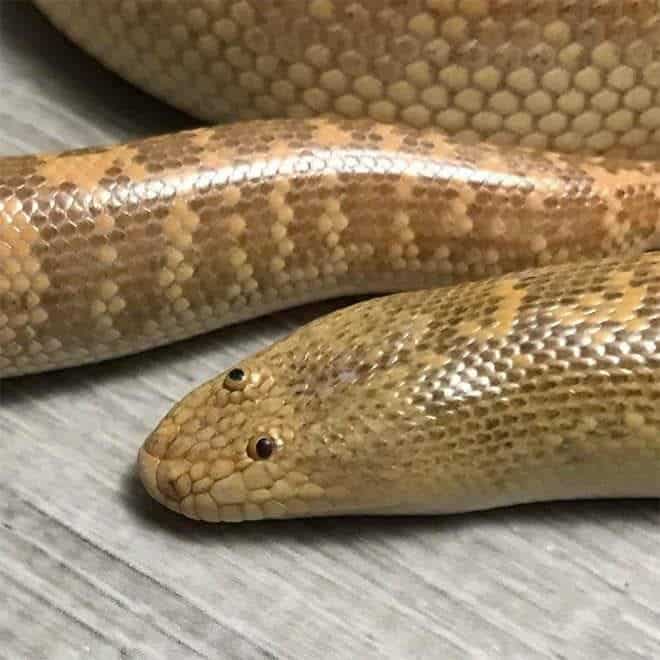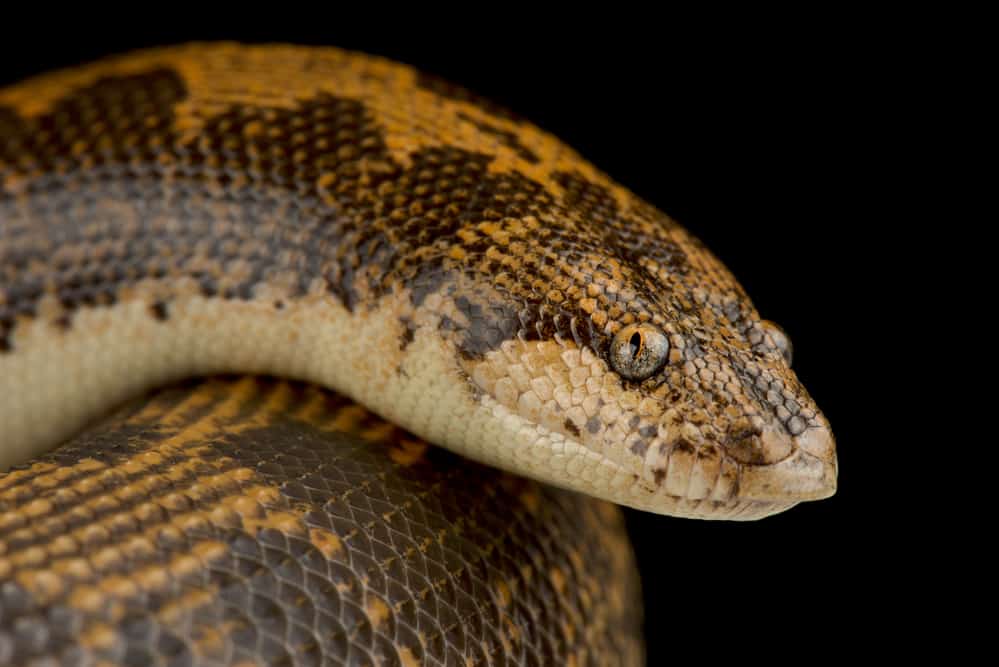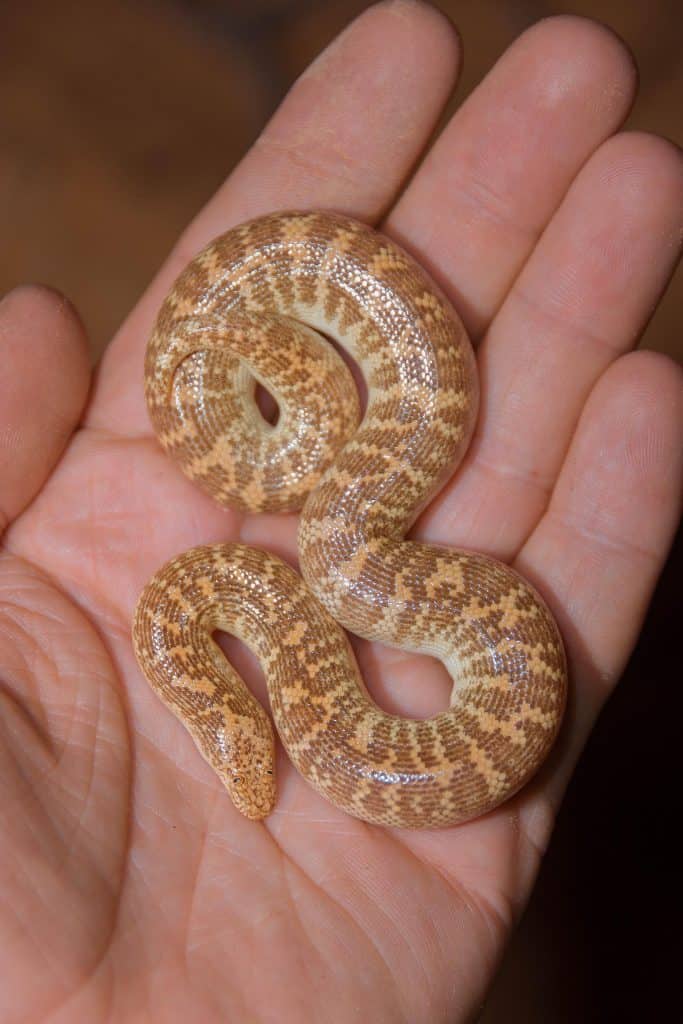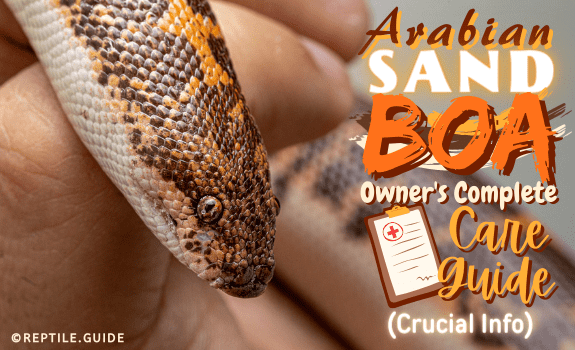Thanks to its bizarre appearance and behaviors, the Arabian sand boa (Eryx jayakari) is a true oddity among boas, and snakes in general.
This article will explore this fascinating species as well as the sand boa group as a whole.
In This Article
Background Information
The family Boidae consists of two subfamilies: Boinae and Erycinae.
The subfamily Boinae includes species like the boa constrictor and the emerald tree boa.
The subfamily Erycinae includes the sand boas.
The 10-foot South American boa constrictors and the 16-inch Arabian sand boa are in the same family!
As a group, sand boas have a distribution that covers the southern regions of the northern hemisphere. You can find them in:
- India
- Africa
- Arabia
- Sri Lanka
- Asia Minor
- Northern Mexico
- Southern Europe
- Western United States
The Arabian sand boa lives in the deserts of:
- Oman
- Kuwait
- Yemen
- Saudi Arabia
These snakes also occur in the Bushehr, Khuzestan, and Kerman Provinces of Iraq.
The Arabian sand boa is the only boa found in the Arabian Peninsula.
The Kenyan sand boa, a close relative of the Arabian sand boa, is a popular pet. It’s range covers East Africa, Egypt, Kenya, Niger, and Ethiopia.
All sand boas are expert burrowers and spend their days underground. They’re active at night and hunt by ambushing their prey.
They lie underground with just their heads exposed as they wait for prey to approach them. They exhibit this same behavior in captivity.
The Arabian Sand Boa is a Rule Breaker!
In 1890, paleontologist Louis Dollo developed a principle known as Dollo’s Law.
The law states that evolutionary changes can’t be reversed.
In other words, if a primate loses its tail during the course of evolution, the species shouldn’t be able to regain its tail.
A few species of animals have broken this law, one of which is the Arabian sand boa.
Sixty million years ago, the family Boidae evolved from being egg layers to becoming viviparous. Viviparous animals give birth to live young.
The Arabian sand boa is one of only two species of boas that lay eggs.
Though this small snake has returned to its egg-laying ways, it didn’t fully regain its former abilities.
The reason for this is that the embryos of these snakes lack an egg tooth.
The embryos of birds and reptiles have an egg tooth, which is a protrusion used to break out of the eggshells upon hatching.
Arabian Sand Boa Vs. Kenyan Sand Boa
The Kenyan sand boa is the most common pet sand boa. We’ll compare the traits of the two species to help you know which is which.
Appearance
Arabian sand boas and Kenyan sand boas have similar coloration.
Both snakes have a dark pattern over a background that’s yellow, yellowish-grey, orange, or sandy brown.
In the Arabian sand boa, the pattern may be darker and more refined.
However, there’s a bigger difference in the coloration underneath.
The belly of the Arabian sand boa is yellowish or whitish, while that of the Kenyan sand boa is cream or snow-colored.
The biggest difference between the two snakes is in the eyes. The eyes of the Arabian sand boa are on top of its head.

Image credit: u/WildAnimus (via Reddit.com)
In the Kenyan sand boa, the eyes are on the sides of the head.

Availability
While the Arabian sand boa is very difficult to find in the pet trade, the Kenyan sand boa is commonly available.
Morphs
With a few exceptions, no one breeds the Arabian sand boa in captivity.
As a result, there are no morphs for this species.
However, there are a variety of morphs for the Kenyan sand boa.
Arabian Sand Boa Care
Should you miraculously come across an Arabian sand boa for sale, its care would be similar to other sand boa species.
Let’s take a look at the care requirements for sand boas.
Enclosure
Because of their small size, you can keep adult sand boas in a 15-20 gallon aquarium. A 10-gallon aquarium is adequate for younger snakes.
Some keepers house sand boas in sweater boxes with holes drilled in the lid for ventilation.
You can use vision cages for sand boas. However, it can be difficult to add a deep enough substrate due to the location of the cage doors.
Substrate
Sand boas love to bury themselves, and their name suggests that sand would be the substrate to use in their enclosure. However, this ISN’T the case.
In their natural habitat, most species of sand boas don’t confine themselves to sandy habitats.
Of all the sand boa species, you’re most likely to find the Arabian sand boa in sandy deserts. However, even they venture into other habitats.
There are different schools of thought about using sand as a substrate in captivity.
Some keepers express concern that sand may cause impactions if swallowed by the snake.
The following are some of the better substrates for sand boa enclosures:
- Newspapers and Paper Towels: It may sound crazy, but some keepers advocate using shredded newspaper or paper towels as a substrate.
Use enough to create a deep enough layer so that your snake can burrow in it.
Since it’s absorbent, and tends to turn to pulp when it gets wet, you’ll need to replace this substrate often.
- Aspen Chips: As with any substrate, make it deep enough so that your snake can bury itself in it.
When using aspen chips, stir the chips around daily to keep them loose and allow the chips below to get exposure to the air.
Remove and replace the chips weekly.
Don’t use the following items for substrate:
- Pine or cedar chips: These contain oils that can be irritating to your snake.
- Savannah Chips: Also known as beechwood, these chips can become compressed with time, making it difficult for the sand boa to burrow.
- Gravel: Gravel can be difficult for the snake to burrow in due to its weight.
It also has many sharp edges that can damage your boa’s skin.
- Sand: Many sand boa species naturally live in habitats other than sandy deserts.
The Arabian sand boa is one of the few sand boa species that naturally occur in sandy habitats. However, even they do well in substrates other than sand.
If you don’t use sand in the enclosure, you’ll eliminate any concerns about the snake developing impactions.
If you’re going for a natural look, try a mixture of ¾ topsoil and ¼ sand.
Pro Tip: Some keepers feed their sand boas in a separate container to avoid having the snake ingest substrate.
If you use this method, you can use sand as a substrate.
Lighting
Sand boas are nocturnal and spend the daylight hours buried beneath the surface.
Despite this, we encourage you to give them a full-spectrum day and night cycle.
Some keepers believe that UVB lighting, though not essential, is beneficial to these snakes.
Besides contributing to a day and night cycle, your sand boa can also get health benefits from it.
Temperature
You should keep the enclosure temperature at 80-95 °F.
We recommend using an under-tank heater with a thermostat.
Keep the enclosure temperature under 95 °F. The night-time temperature can drop to the mid-70s.
As with other reptiles, it’s important to provide your sand boa with a temperature gradient.
In other words, you want to set up the tank so that there’s a warm end and a cool end.
Doing this will allow the snake to find the temperature that best meets its needs at any given moment.
You can accomplish this by positioning the under-tank heater so that it heats only a third of the tank.
Humidity
Keep the relative humidity in the enclosure under 50%.
You can attain low humidity by providing plenty of ventilation and keeping the water bowl at the cool end of the enclosure.
When your boa sheds, increase the humidity by providing a humid hide.
A humid hide is an additional hide equipped with damp moss or paper towels.
The moist substrate releases moisture into the air, raising the humidity in the hide.
Without this added help, sand boas may have trouble shedding properly.
Hides
Though sand boas take refuge under the sand, we still recommend providing two hides.
You can place one hide at the hot end of the tank and one at the cool end.
Doing this will give your snake an additional sense of security.
Water Dish
Provide a small but heavy water dish for your pet. The water dish must be heavy so that your boa doesn’t overturn it.
Feeding
In the wild, sand boas normally feed on small mammals and lizards.
They’re ambush hunters that hide under the sand with just their heads exposed.
When a prey item gets close enough, they’ll strike and constrict their prey.
When feeding captive sand boas, offer prey that’s no larger than the widest part of your snake.
We recommended that you feed only dead feeders to your sand boa.
Live feeders, especially mice and rats, can bite and injure your snake.
You can buy frozen feeders, which will also prevent the transmission of parasites, which can occur when offering live prey.
Since sand boas are nocturnal, it’s best to feed them at night.
In captivity, sand boas may be reluctant to take food. You can use the following tips for getting picky eaters to accept their meals:
- Experiment with Different Meals: For example, if your snake doesn’t accept mice, try small rats.
You can feed the following prey items to captive sand boas:- Hampsters
- Small rats
- Mice (Many sand boas favor nestling mice as prey)
- Lizards (especially of the genera Sceloporus and Anolis)
- Food Size and Time: As mentioned earlier, the size of the prey is important, as is the time of day. Offer your sand boa small prey items at night.
- Dry Out the Snake
As a last resort, try to get reluctant eaters to eat by removing their water dish and increasing the enclosure’s temperature by a few degrees.
Do this for a week and then offer the snake a dead feeder that’s been dipped in water. Use forceps or tongs when offering it to the snake.
The snake may first drink the water that rolls down the prey but then actually eat it.
This method has worked with both saw-scaled sand boas and Russian sand boas.
It’s important to do as much research on your sand boa species as possible to understand its habits and the kind of prey it normally takes.
Feed adult sand boas every seven to ten days. You can feed younger snakes every five to seven days.
Temperament & Handling
Sand boas are docile snakes and rarely bite. They’re slow-moving and take well to handling.
Because of their temperament and small size, they make great pet snakes for beginner snake keepers. This is especially true of the Kenyan sand boa.

Image credit: u/thewildgingerbeast (via Reddit.com)
Health Concerns
The following are signs of potential health or husbandry issues:
- Shedding Difficulties: Shedding issues include the skin coming off in patches instead of a whole piece.
Another issue is if the snake retains the eye caps after shedding.
Shedding issues are often due to not having the proper humidity level. Providing a humid hide may remedy this.
- Obesity: Many sand boas are voracious eaters. If you overfeed them, it can lead to obesity.
You can prevent this by only feeding adult sand boas every seven to ten days and young sand boas every five or seven days.
- Mites and Ticks: Mites and ticks are parasites that can infest your snake.
If you find any mites or ticks, you should contact a veterinarian who is experienced with reptiles.
Breeding Sand Boas
Of the 13 species of sand boas, three of them breed regularly in captivity. These three are:
- Indian sand boa (Eryx johnii)
- Kenyan sand boa (Eryx colubrinus)
- Rough scaled sand boa (Eryx conicus)
Sand boas species that sometimes breed in captivity include:
- Desert sand boa (Eryx miliaris)
- Tartar sand boa (Eryx tataricus)
- Spotted sand boa (Eryx jaculus)
The remaining species have rarely been bred or never have been bred in captivity.
Determining the Sex of Sand Boas
Determining the sex of sand boas is easy as the females are much larger than the males.
Also, the tails in proportion to body length are much smaller in females than in females. In some cases, the spurs of males may be evident.
Breeding Age
It’s easy to determine the breeding age of sand boas in captive animals. Captive snakes reach breeding age when they attain a length of three to four feet.
For the Kenyan sand boa, the female normally reaches sexual maturity upon reaching a length of 18 inches and a weight of 200 grams.
For males, it will be when they reach 15 inches in length and a weight of 70 grams.
For the rough-scaled sand boa, sexual maturity is reached when females reach 18 inches and a weight of 250 grams. For males, it’s 15 inches and 70 grams.
For the desert sand boa, females reach sexual maturity at 18 inches and 160 grams, while for males, it’s 12 inches and 35 grams.
Never try to accelerate the growth rate of sand boas, as doing so will compromise their health.
Encouraging Breeding
When you have sexually mature snakes, the next step is to stimulate them to breed. You can do this by altering their environment.
Since different species come from different parts of the world, how you alter their environment is determined by the species you’re trying to breed.
The most common way to alter the captive environment is to enact what is known as brumation. Brumation is a period of inactivity due to lower temperatures.
Brumation isn’t the same as hibernation. In hibernation, the bodily functions of the animal all but stop. In brumation, the body is still functioning, just at a slower speed.
Breeders sometimes induce brumation by lowering the temperature of the enclosure for a period of two weeks.
When inducing brumation in your snakes, don’t feed them as they may not be able to digest their meal properly.
Introducing the Snakes to Each Other
Sand boas breed year-round; however, you want to wait a week after the brumation period has ended.
A week after returning the enclosure to normal temperatures, feed your sand boa again.
Offer a small amount of food twice a week for two to three weeks as you gradually work back to your snake’s regular feeding schedule.
When this period has been completed, you can introduce your snakes to each other.
Breeding often occurs within the first four hours of introduction. However, leave them together for four days and then separate them.
When a week has passed, repeat the process two or three times until you believe the female is gravid.
If the pair don’t breed, you can try to match your male with another female.
Some breeders suggest introducing a second male to the exhibit to create competition.
If you try this method, only do so for a few minutes. Keep an eye on them as males may fight.
Gestation Period
The gestation period for sand boas is around four to six months, depending on the temperature.
At that time, your sand boa will give birth to live young. This is assuming that you don’t have an egg-laying species.
As the egg-laying species (the Arabian sand boa) is usually difficult to get, your sand boa will likely give live birth.
With prior research on the care of the sand boa, this snake can be an ideal pet snake, regardless of the skill level of the keeper.
Arabian Sand Boa Price
Since this species isn’t common in captivity, the prices vary drastically.
You can expect to pay between $200 and $1,000 for these snakes depending on the animal’s origin, age, and the seller.
The large price difference is due to the species’ unavailability in the pet trade. People who manage to breed them can name their price, and somebody will pay it.
Are Arabian Sand Boas Good Pets?
If you can get one, the Arabian sand boa is a good pet.
The Arabian sand boa is difficult to obtain for several reasons. The first reason is that some of the countries that they come from don’t normally export wildlife.
It has been a challenge to get imported specimens to eat.
However, since that’s a common problem with sand boas, it’s not unexpected.
In every other respect, Arabian sand boas make excellent pets.
If you’re interested in getting a sand boa, consider other species that are widely available. The Kenyan sand boa is a good candidate.
Is the Arabian Sand Boa Dangerous?
The Arabian Sand Boa isn’t dangerous.
At a length of 16-inches, the Arabian sand boa isn’t large enough to constrict a person. It isn’t venomous, and it has a gentle temperament.
As with other sand boa species, the Arabian sand boa rarely bites. When it feels threatened, its defensive strategy is to roll up in a ball.
What do Arabian Sand Boas Eat?
A research study conducted in the wild analyzed the food contents found in the stomachs of Arabian sand boas. They discovered the following:
- Lizards made up 50% of the stomach contents.
- For larger snakes, rodents made up 25% of the stomach content.
- Arthropods, which mainly consisted of beetles, made up 12.5%
- The remaining 12.5% was unidentifiable.
They identified some of the lizards, which included:
- Acanthodactylus schmiditi
- Bunopus tuberculatus
- Stenodactylus slevinii
Rodent prey included:
- Gerbillus cheesmani
- Gerbillus nanus
How do Arabian Sand Boas Catch their Food?
Arabian sand boas are nocturnal ambush predators.
The boa lies underneath the desert sands with just its eyes exposed above the surface.
When the prey gets close enough, the snake strikes at the prey and constricts it.
There are some reports of Arabian sand boas hunting during the daytime.
Is the Arabian Sand Boa Endangered?
The Arabian sand boa isn’t endangered.
According to the International Union for Conservation of Nature (IUCN), the Arabian sand boa is common in its natural habitat.
It’s classified as Least Concern (LC), meaning that it’s not in any danger of extinction.
Are There Sand Boa Morphs?
There are no Arabian sand boa morphs, but there are morphs for other sand boa species.
This is especially true for the Kenyan sand boa. The morphs for this species include:
- Snow Kenyan sand boa
- Albino Kenyan sand boa
- Anerythristic Kenyan sand boa
- Paradox albino Kenyan sand boa
- Paradox snows Kenyan sand boa
In addition, some variations are bred from these morphs that include:
- Nuclear
- High Whites
- Reduced Patterns
How Long Do Sand Boas Live?
The more commonly kept sand boa species live for up to 20 years with proper care.
In the wild, sand boas live for around 15 years.
Are Sand Boas Built Different From Other Boas?
Yes, they have evolved to adapt to a burrowing lifestyle. Their eyes are small and, in some species, are positioned higher up.
The positioning of the eyes is highest in the Arabian sand boa. They’re located on top of the head.
Sand boas also have small hard scales, making it easy for them to move through the sand.
Additionally, their skull is denser than other snakes, and the vertebrae of their tails are few in number but larger in size.
How Do Sand Boas Reproduce?
Most species of sand boas are ovoviviparous. The female retains her eggs in her body and gives birth to live young.
This is true for most other members of the family Boidae.
Only two species of boas lay eggs: the Arabian sand boa and the Calabar python.
The Calabar python is no longer classified as a python and is now considered part of the Erycinae subfamily.
If you truly want a sand boa, consider getting the Kenyan sand boa. Of all the sand boa species, it’s the most commonly available species.
We hope you’ve enjoyed this article about Arabian sand boas.
Alternatively, if you’re an intermediate-level keeper looking for more of a challenge, the dumeril’s boa might suit you better.
Our website offers plenty of boa-related content that you might enjoy.
Check out our articles about the rubber boa, emerald tree boa, or the rosy boa for a few of the more typical boa species.
We also have some other care sheets for fascinating boas like the Brazilian rainbow boa or the Amazon tree boa.
Have you ever seen an Arabian sand boa in person? Let us know in the comments!
